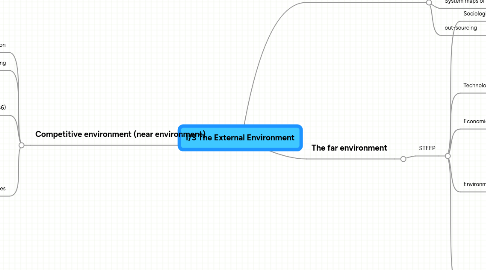
1. Competitive environment (near environment)
1.1. Analysing the competition
1.2. Benchmarking
1.3. Greenley (1986)
1.3.1. Nature of competitors and any changes
1.3.2. Competitor's objectives and strategies
1.3.3. Strengths and weaknesses
1.3.4. Effects of competitors on own organisation
1.4. Porter's five forces
1.4.1. Industry structure
1.4.2. Threat of new entrants
1.4.3. Bargaining power of customers
1.4.4. Bargaining power of suppliers
1.4.5. Threat of substitue products or services
2. Organisational Boundaries
2.1. Environment
2.1.1. Internal environment - control
2.1.2. External environment
2.1.2.1. Near environment - influence
2.1.2.2. Far environment - respond
2.2. System maps of changing organisational boundaries
2.3. out-sourcing
2.3.1. advantages
2.3.2. disadvantages
3. The far environment
3.1. STEEP
3.1.1. Sociological
3.1.1.1. Demographic changes
3.1.1.2. Patterns of work
3.1.1.3. household structure
3.1.1.4. Patterns of consumption
3.1.1.5. Gender roles
3.1.2. Technological
3.1.2.1. ICT lowers barriers of time and place
3.1.2.2. ICT creates new industries
3.1.2.3. IT has changes (and replaced) internal roles
3.1.3. Economic
3.1.3.1. Economic cycles of supply and demand
3.1.4. Environmental
3.1.4.1. Legislation
3.1.4.2. Information
3.1.4.3. Employees
3.1.4.4. Shareholders
3.1.4.5. Pressure groups
3.1.4.6. Customers
3.1.5. Political
3.1.5.1. Health and safety regulations
3.1.5.2. Trading relationships
3.1.5.3. Government as a customer
3.1.5.4. public servies as supplier
3.1.5.5. etc.
